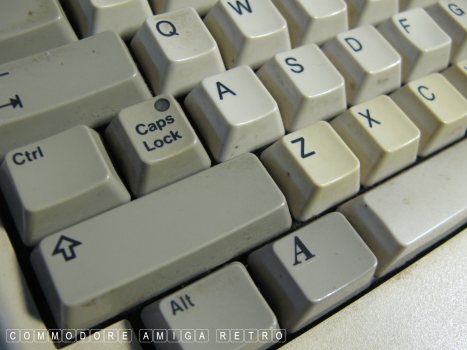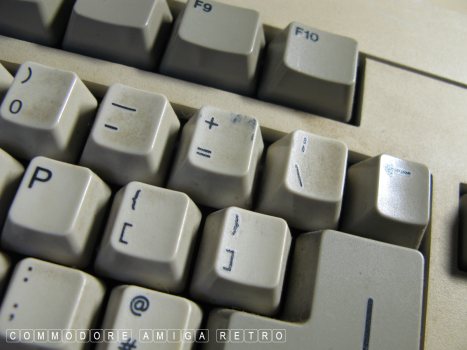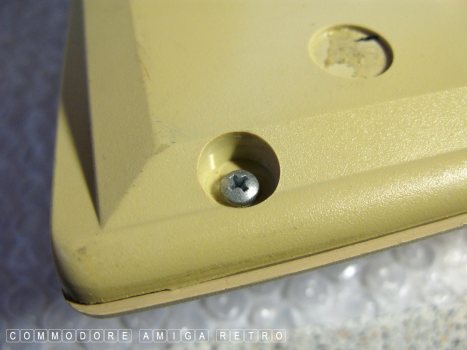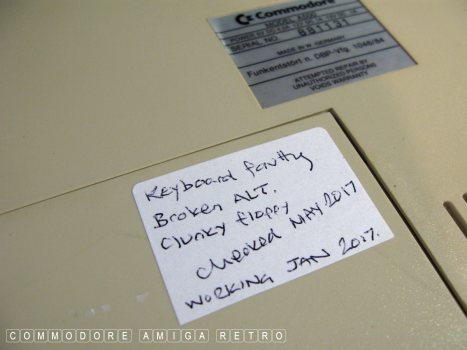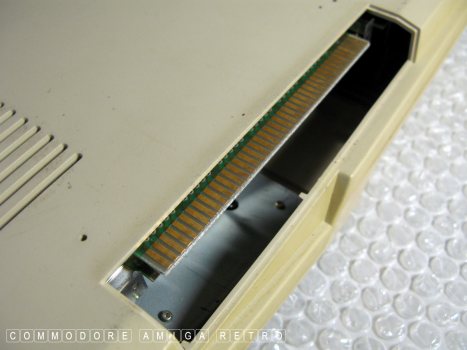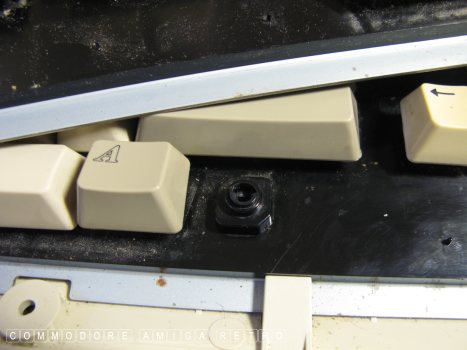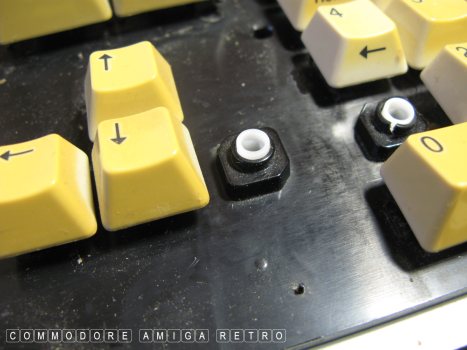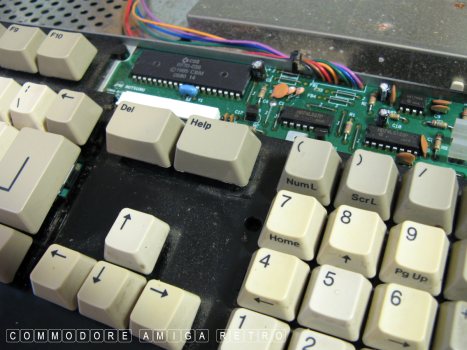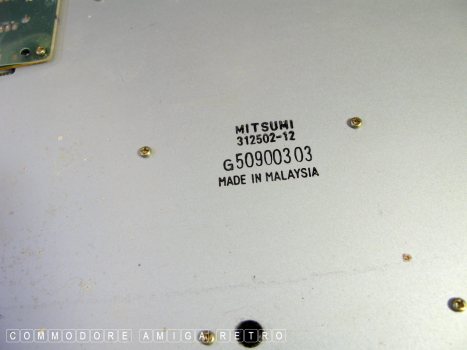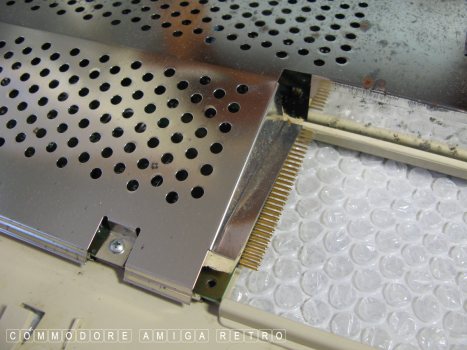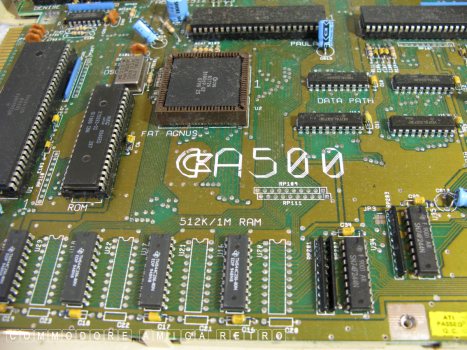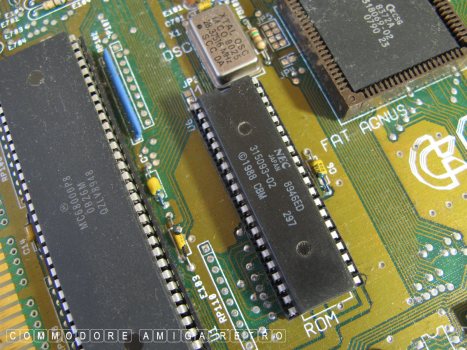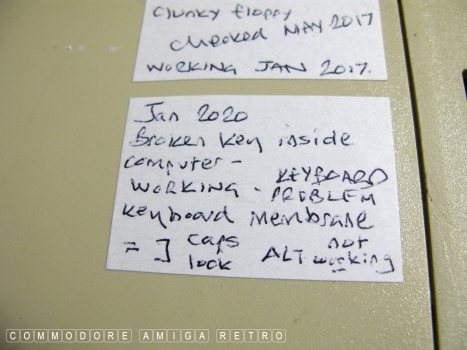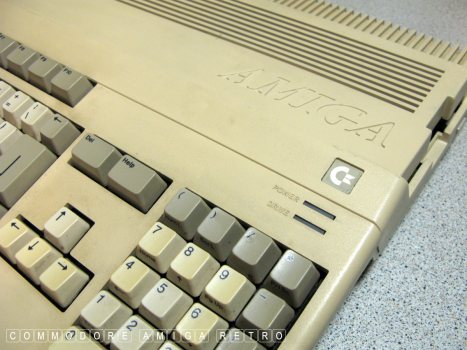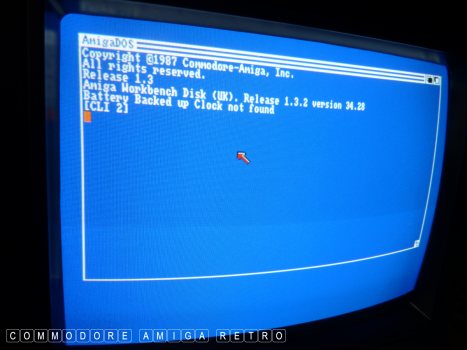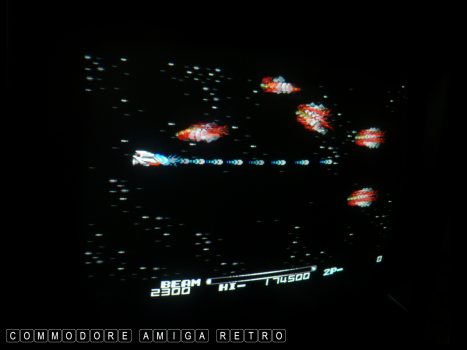
The real deal ... a genuine Amiga 500.
Not a bad shade of grey. Not that it bothers me.
The ALT key just pops off sadly.
The reason is that half the pillar
Also the CAPS light doesn't work. And
The other keys not working are the
Knowing whether all the keys work is
A new membrane will cost between £15 and £25
Check case to left of ESC key for signs
The floppy on this drive was clunking and
The drive should simply click gently when
Check for disk and power LED lights on keyboard.
This case has suffered from a metal
Amiga 500s were used extensively as a
Mouse issues can only by diagnosed from
Never throw anything away and store
Screws can be either Philips or star
The white rubber feet had perished and
Warranty sticker is broken so a green
When I check a computer I put a sticker
This computer was made in West Germany.
What is inside the trapdoor can always
Check the side expansion connector for
OK let me see what I can do with this
A good time to clean the keys. Always
There were quite a number of different
If you ever leave a keyboard with a
Also never lean an Amiga against something
Anyway, this is an old keyboard that I
Check the connector from the keyboard
There is a plastic black tie to the
Mitsumi is a good sign and all
This will be a separate project.
OK nothing in the trap and time to
Check the shielding for rust and don't
There is no need to remove the floppy
A genuine Amiga 500. Note the empty bank
Motherboards may vary in colour.
The ROM has the writing on the other
Most chips have a simple date code like
The FAT Agnus socket is not standard.
Sometimes there are holes in the base of
Some strange discolouration below R405
Check that all pins appear seated and
And there should be no battery
Useful knowing the boards Revision No.
I don't worry myself with the light blue things.
Check for corrosion and rusting along
You could check pins to drive and
If you want to recap then that is up to
OK the trap door pocket has all kinds of use.
So I update the sticky on the trapdoor cover.
This will be tomorrows project
So the acid test... Is she working ?
The Amiga 1.3 disk requester. Looking good.
Loading screen and checking mouse movement.
Icons on the right, 351464 memory at the
Sadly those keys are still broken. If you
You can also check the joystick port by
And then some hours later, switch
ScuzzBlog: Diaries October 2023
Entry 8th October 2023: Post 1: Why buy an Amiga?
Why buy an Amiga?
A question that comes up a lot is one that encourages folk to buy
an Amiga. My response to anyone getting excited about buying an
Amiga is relatively straight forward. I remind them that in this
day an age you don't need an old record player to listen to and
enjoy old recorded music.
Most that want an old computer also want the facility to transfer
files from the internet to their Amiga. In truth it would be much
simpler and cheaper to just use the emulator. I am not discouraging
people from buying the actual thing, I am just sensitive to valued
and treasured rare kit being vulnerable to neglect if the owner
becomes bored with it. I am more than happy with true enthusiasts
pairing up with old kit. What I am mindful of is the destructive
nature of a fad that goes bad ways.
So first thing first why not try out the emulator and if you become
ever more keen then by all means invest in an Amiga.
Next thing I guess is understanding that this is old kit. Users do
need to appreciate the workings of the Amiga and have some basic
knowledge of computer electronics. The systems are fraught with
issues and knowing if it's software, hardware, data storage or power
say is so important. A simple thing could cripple the system and
worse cause the owner to start picking around the insides without
the first clue of what they are doing. To disastrous consequences.
If the user only wants to play games my guess is the machine will
be subject to a Gotek modification. In addition the case may get the
retrobrite treatment. In each instance the process may be hazardous
to the Amiga especially if a project goes wrong and then the user
loses interest.
It is easy to see the wizardry on the various forums and websites
and desire to be part of it. But the guys like me that are nutters
have probably spent a good part of their lifetime with their addiction.
This is not something that has happened over a couple of months.
So being prepared for the long haul, being patient, being willing
to shell out bags of cash, and being able to deal with upset all
is part of the joy. If after the first troublesome problem a user
gives up then this places the hardware at risk. Remember that my
primary concern is in the longevity of rare kit. We need to find a
good home for all our aged home computers.
An Amiga can be emulated both on PCs and with other kit that can
equally perform better, faster, more efficiently than the original
Amiga. There are any number of options.
I do not want to put off anyone from buying an Amiga, but before
you take the plunge it's worth familiarising yourself with what is
involved and seriously play on the emulator for a while.
Anyhoo, that is all I wanted to say. Below is a blog I wrote in
2020 on buying an Amiga 500. The same applies to any Amiga so it
is worth referencing when discussing this matter.
Amiga 500 - Buyers Beware.
In need of a deep clean and that's about all.
is broken off. The top half.
it's not the LED cus it flashes when
the A500 boots up.
right square bracket and the plus key.
quite important when buying. Plus are they
all there and in the correct order. Also
check for discolouration of certain keys
cus they may have been added later. Although
the Amiga 500 has mouse and joystick, many
games were very keyboard intensive.
but broken key pillars/supports would need to
be found and that aint easy.
of cracking from lifting the case open
incorrectly from the bottom edge.
scraping across disks until I cleaned
and serviced the head and disk sensors.
without disk in place. It shouldn't seek
a disk when not active. Also watch out for
DF0:??? errors on screen after boot.
Older machines have red power lights not green.
Also the older machines have red CAPS lights.
case to an external floppy drive being
scraped or dropped on the case. The
flat area to the head of the 500 is
quite inviting for disk boxes, drives
and coffee cups. So check for damage.
games machine. Consequently the joystick
and mouse ports got hammered. Check for
all pins in the port interfaces.
using the machine. Often a faulty chip
like the DENISE will cause the mouse
pointer to jump over icons and not click
them. When the machine is booting I always
move the mouse pointer to see I have smooth
horizontal and vertical movement.
in a sealed plastic bag inside the A500.
so ALWAYS use the correct screwdriver.
gone all sticky so I removed them.
light to open up. Also means she has been
opened up before. If still intact then
glass case or sell. I never break seals
on Amiga 500s. ' Nothing to see here '.
on the trap door. NOT the main case.
Always update when finished.
be a hidden surprise so I don't ask.
wear and check for a grey grounding clip
used on sidecars. Also the colour of the
cover may vary from the main case, which
often shows a side car had been attached.
busted ALT key.
do this with cotton buds and folded paper
NEVER and I mean NEVER remove the keys
and wash in the sink or dishwasher.
Never place unnecessary stress on fragile
and aged plastics. You reduce the life
expectancy each time you do idiot things
like this. AND NEVER remove the top
coating by chemical processes. Just
live with it. It's an old computer !!!
keyboard mechs adopted by Commodore
This one uses an inner plastic pillar
which is removed from below.
broken key like this remember that
without the spring it is always in the
depressed position. It is a bit annoying
if it happens to your escape key.
with the keys depressed. And NEVER EVER
place any object on the keyboard other than
a dust cover. if you can't afford a dust cover then
use some kitchen roll to cover keys and port slot.
use for salvaging parts.
as on the older machines this was a ribbon.
wires as they meet the green PCB. If it
is not there it means the keyboard has
been taken apart at some time.
those little screws need to be removed.
remove the four screws to the shielding.
cut yourself.
drive. The case often rusts.
Note the two tiny black switches just
inside the case on the left. A good time
to press them down gently and make sure
they are free and bouncing up and down.
of RAM slots at the base of the computer.
This one is the pale green which
comes from West Germany as it once was.
way round to the main 68000 adjacent.
The half moon to the CPU is at the
bottom. The half moon to the ROM is
at the top. If they are not then that
is probably why the computer is not
working. The ROM here is the 1.3 1988.
the FAT AGNUS 0790 or the seventh week
of 1990... which dates this computer.
They are normally black and the pins
more visible. Not sure I would want to check.
the motherboard to let you push out the
FAT AGNUS. If not use the correct tool.
and has washed out the number, though
the tracks are clear and not damaged.
not bent and discoloured. Also check for
white residue on the motherboard around
chips.
or empty battery location.
Here it is Revision 6A.
this base edge which may indicate it
has been stored in a damp loft or garage.
or the motherboard. However, unplugging
and plugging in can place unnecessary
distress on the computer so I leave alone.
you. I only fix stuff when it is broken.
These are old computers and have become
quite fragile.
head and Workbench 1.3 opens.
open the SHELL and type in all the keys
plus the capitals and special keys you
identify if any are broken.
firing up R-Type II.
the lights on cus its probably
gone dark while you play. Happens
to me all the time.
Come back tomorrow and I'll fix that keyboard.
TRUST ME !!

If you can only see this CONTENT window
then click the image above for the full site
Last updated 8th October 2023
Chandraise Kingdom
![]()
Keep the Faith
scuzzscink 2023





